- Details
- Written by: Elmazen
- Category: Flags of Countries of the World
- Hits: 674
Flag of the Federated States of Micronesia
Flag of the Federated States of Micronesia, Currency, Population, Tourist Places, Borders, Culture
Federated States of Micronesia: A Unique Island Nation
The Federated States of Micronesia (FSM) is an enchanting island nation located in the western Pacific Ocean.
Known for its vibrant culture, stunning landscapes, and intriguing history, FSM offers a glimpse into a unique way of life.
Let’s dive into some key facts about this captivating nation.
Flag of the Federated States of Micronesia
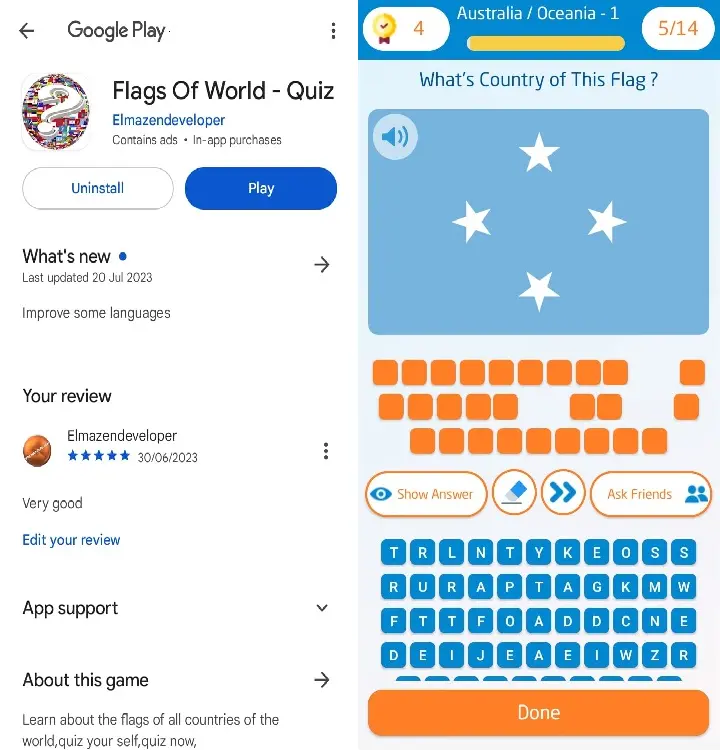
Download the application  Flags Of World - Quiz ,
Flags Of World - Quiz ,
And test your knowledge with Flags of World ,
1. Population of the Federated States of Micronesia
As of November 2024, the Federated States of Micronesia has a population of approximately 527,600 people.
Spread across four states-Yap, Chuuk, Pohnpei, and Kosrae-FSM’s population is diverse, with strong community ties and a rich cultural heritage.
2. Federated States of Micronesia Country Flag Meaning
The flag of FSM features a light blue background with four white stars arranged in a diamond pattern.
The blue represents the vast Pacific Ocean surrounding the islands, while the four stars symbolize the four states of the federation: Yap, Chuuk, Pohnpei, and Kosrae.
The flag signifies unity and the shared connection of these states despite their geographical separation.
3. Federated States of Micronesia Currency
The official currency of FSM is the United States Dollar (USD).
This is due to the Compact of Free Association between FSM and the United States, which also governs their economic and political relationship.
Flag of the Federated States of Micronesia

Download the application  Flags Of World - Quiz ,
Flags Of World - Quiz ,
And test your knowledge with Flags of World ,
4. Borders of the Federated States of Micronesia
FSM does not share any land borders, as it is an island nation.
However, it is surrounded by vast stretches of the Pacific Ocean.
Neighboring countries and territories include Palau to the west, the Marshall Islands to the east, and Papua New Guinea to the south.
5. Culture of the Federated States of Micronesia
FSM’s culture is deeply rooted in traditions that have been passed down through generations.
Some highlights include:
- Traditional Navigation: The people of FSM are renowned for their ancient skills in celestial navigation, using the stars and ocean currents to travel vast distances.
- Dance and Music: Traditional dances and songs play a vital role in ceremonies and celebrations, reflecting themes of nature, history, and spirituality.
- Weaving and Craftsmanship: Skilled artisans create intricate woven mats, baskets, and traditional clothing from local materials.
- Cuisine: Local dishes feature taro, breadfruit, fish, and coconut.
Many meals are prepared using traditional cooking methods, like underground ovens.
Community and family are to daily life, with an emphasis on sharing and cooperation.
6. Best Places to Visit in the Federated States of Micronesia
FSM is a haven for nature lovers, history enthusiasts, and adventure seekers.
Here are some must-visit destinations:
- Nan Madol (Pohnpei): Often called the “Venice of the Pacific,” this ancient city of stone is a UNESCO World Heritage Site and a marvel of engineering.
- Chuuk Lagoon: A paradise for divers, Chuuk Lagoon is home to shipwrecks from World War II, vibrant coral reefs, and abundant marine life.
- Yap Island: Known for its traditional stone money and manta ray diving spots, Yap offers a unique cultural and underwater experience.
- Kosrae's Lelu Ruins: These ruins showcase the remnants of an ancient Micronesian city and provide insight into the island's history.
- Ant Atoll (Pohnpei): A pristine atoll with white sandy beaches and crystal-clear waters, perfect for snorkeling and relaxation.
Conclusion
The Federated States of Micronesia is a land of breathtaking beauty and deep cultural significance.
From its welcoming people to its awe-inspiring landscapes, FSM offers an unforgettable experience for those seeking adventure, history, or tranquility in the heart of the Pacific.
Flag of the Federated States of Micronesia

Download the application  Flags Of World - Quiz ,
Flags Of World - Quiz ,
And test your knowledge with Flags of World ,
- Details
- Written by: Elmazen
- Category: Flags of Countries of the World
- Hits: 768
Flag of the Marshall Islands
Flag of the Marshall Islands, Currency, Population, Tourist Places, Culture, Borders
Exploring the Marshall Islands: A Hidden Gem in the Pacific
The Marshall Islands, a picturesque island nation in the Pacific Ocean, is a destination rich in history, culture, and natural beauty.
Here’s everything you need to know about this enchanting country:
Flag of the Marshall Islands
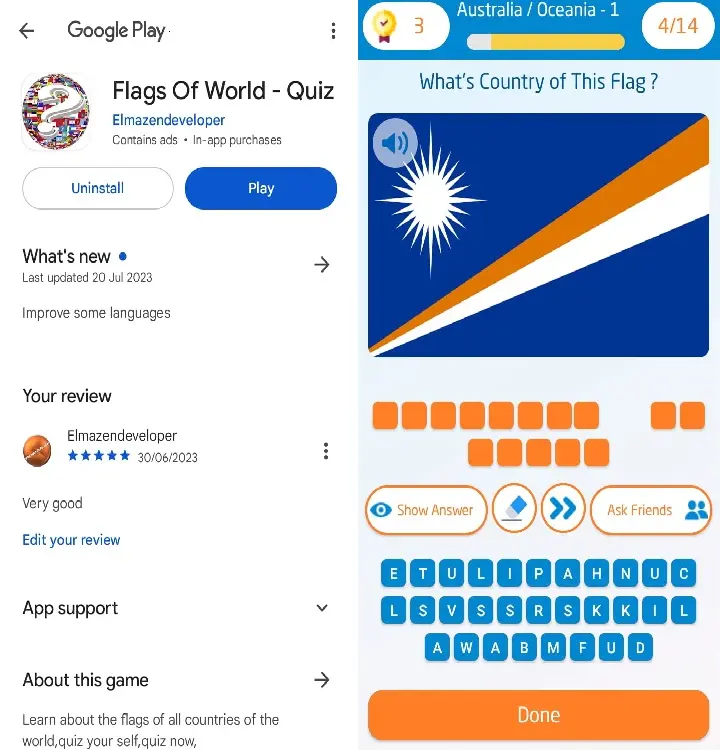
Download the application  Flags Of World - Quiz ,
Flags Of World - Quiz ,
And test your knowledge with Flags of World ,
1. Population of the Marshall Islands
As of November 2024, the Marshall Islands is home to approximately 37,000 people.
Most of the population resides on the main atolls, such as Majuro (the capital) and Ebeye.
The country has a young population, with a vibrant community that maintains its traditions and customs.
2. Meaning of the Marshall Islands Flag
The flag of the Marshall Islands is a vibrant symbol of unity and pride.
It features a blue field with two diagonal stripes-orange and white-extending from the lower left corner.
A white star with 24 points sits in the upper left.
Here's what it represents:
- Blue background: The vast Pacific Ocean surrounding the islands.
- Orange and white stripes: The two main chains of the islands-Ratak (Sunrise) and Ralik (Sunset).
- 24-pointed star: The 24 electoral districts, with the four elongated points representing the capital and major cultural hubs.
3. Currency of the Marshall Islands
The official currency of the Marshall Islands is the United States Dollar (USD).
This is because the country has a close relationship with the United States under the Compact of Free Association.
Flag of the Marshall Islands

Download the application  Flags Of World - Quiz ,
Flags Of World - Quiz ,
And test your knowledge with Flags of World ,
4. Borders of the Marshall Islands
The Marshall Islands is a vast archipelago of 29 atolls and 5 isolated islands, covering over 750,000 square miles of ocean.
It does not share direct land borders with any other country but lies near:
- Kiribati to the southeast,
- Nauru to the southwest,
- Federated States of Micronesia to the west.
5. Culture of the Marshall Islands
Marshallese culture is deeply rooted in community, storytelling, and the sea.
Key aspects include:
- Language: Marshallese (Kajin M̧ajeļ) is the official language, along with English.
- Navigation: Traditional stick charts are a testament to their advanced knowledge of ocean navigation.
- Art: Intricate handicrafts made from natural materials, including pandanus and coconut fibers.
- Music and Dance: Celebrations are marked by traditional songs and rhythmic dances, showcasing the people’s connection to their heritage.
- Cuisine: Local food includes breadfruit, taro, fish, and coconuts, often prepared in traditional ways.
6. Best Places to Visit in the Marshall Islands
For those seeking adventure and relaxation, the Marshall Islands offers a variety of stunning locations:
- Majuro Atoll: The bustling capital, known for its mix of modern amenities and traditional charm.
- Bikini Atoll: A UNESCO World Heritage Site, famous for its historic role in nuclear testing and its world-class scuba diving spots.
- Arno Atoll: A serene retreat for those who want to experience local culture and pristine beaches.
- Kwajalein Atoll: The largest coral atoll in the world, featuring stunning lagoons.
- Aur Atoll: Perfect for fishing and exploring untouched natural beauty.
Conclusion
The Marshall Islands is more than just a tropical paradise-it’s a land rich in history, culture, and natural wonders.
Whether you’re drawn by its fascinating past, vibrant culture, or breathtaking landscapes, this unique destination promises an unforgettable experience.
Flag of the Marshall Islands

Download the application  Flags Of World - Quiz ,
Flags Of World - Quiz ,
And test your knowledge with Flags of World ,
- Details
- Written by: Elmazen
- Category: Flags of Countries of the World
- Hits: 683
Flag of Kiribati
Flag of Kiribati, Currency, Population, Tourist Places, Borders, Culture
Discover Kiribati: A Unique Island Nation in the Pacific
Kiribati, a remote island nation in the central Pacific, offers an enchanting blend of rich culture, scenic beauty, and fascinating history.
Spread across 33 atolls and reef islands, this tropical destination is worth exploring for its distinctive charm.
Let’s dive into some key aspects of Kiribati.
Flag of Kiribati
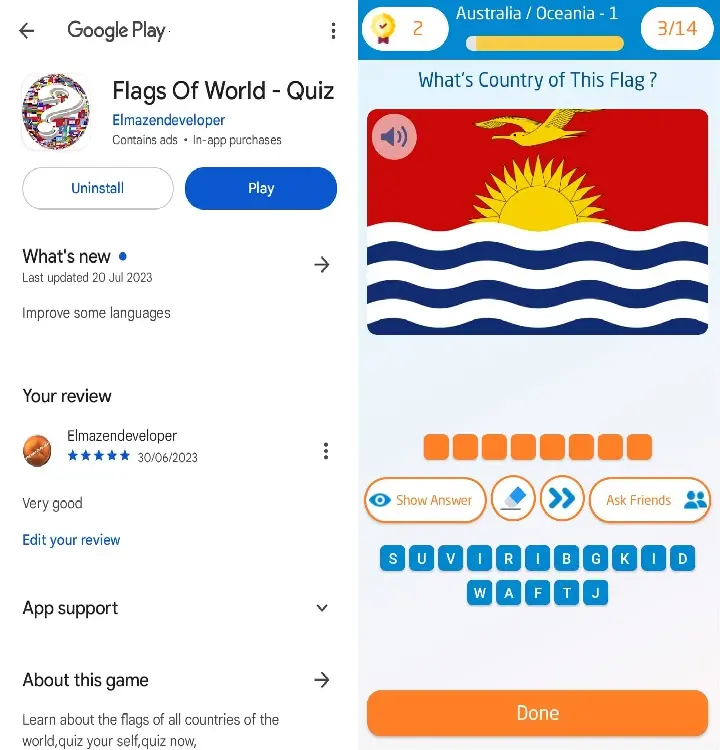
Download the application  Flags Of World - Quiz ,
Flags Of World - Quiz ,
And test your knowledge with Flags of World ,
1. Population of Kiribati
As of November 2024, Kiribati's population is approximately 135,300 people.
Most of the population resides on the atolls of Tarawa, the country's capital, and Kiritimati (Christmas Island), the largest atoll.
The population is predominantly of Micronesian descent, with a strong sense of community and shared traditions.
2. Kiribati’s Flag and Its Meaning
The flag of Kiribati is rich in symbolism:
- Red Background: Represents the sunrise over the Pacific Ocean.
- Yellow Frigatebird: Symbolizes freedom, strength, and command over the sea.
- Three White Wavy Lines: Stand for the three island groups: the Gilbert Islands, Phoenix Islands, and Line Islands.
- Yellow Sun with 17 Rays: The sun signifies the tropical location, while the 17 rays represent the 16 Gilbert Islands and Banaba Island.
3. Kiribati’s Currency
The official currency of Kiribati is the Australian Dollar (AUD).
Despite being an independent nation, Kiribati relies on the Australian currency for its monetary system, reflecting its close ties with Australia.
Flag of Kiribati

Download the application  Flags Of World - Quiz ,
Flags Of World - Quiz ,
And test your knowledge with Flags of World ,
4. Borders of Kiribati
Kiribati is an island nation without land borders.
Its territory spans over 3.5 million square kilometers of ocean.
Geographically, it is located near other Pacific nations such as Tuvalu, Nauru, and the Marshall Islands, but its vast oceanic expanse means there are no direct neighbors.
5. Culture of Kiribati
The culture of Kiribati is deeply rooted in traditional practices and communal living.
Key aspects include:
- Language: The official languages are Kiribati (Gilbertese) and English.
- Dancing and Music: Traditional dances, like the "Te Buki," are integral to celebrations and ceremonies.
- Fishing and Weaving: Fishing is not just a livelihood but also a cultural practice, while intricate weaving of mats and baskets reflects artisanal skills passed through generations.
- Community Values: The people of Kiribati, called I-Kiribati, emphasize mutual support, respect, and harmony within their communities.
6. Best Places to Visit in Kiribati
Kiribati offers a unique travel experience with its pristine landscapes and cultural heritage.
Some must-visit destinations include:
- South Tarawa: Explore the capital for a mix of local life and historical sites, such as World War II relics.
- Kiritimati (Christmas Island): Renowned for world-class fishing, bird watching, and stunning lagoons.
- Banaba Island: A rugged island with rich phosphate mining history and breathtaking views.
- Phoenix Islands Protected Area (PIPA): A UNESCO World Heritage Site, this area features unspoiled marine ecosystems and diverse wildlife.
- Outer Atolls: Visit remote atolls like Abemama, Marakei, and Tabiteuea to experience traditional Kiribati life away from modern influences.
Conclusion
Kiribati is a treasure trove of natural beauty, cultural depth, and serene isolation.
Whether you're interested in exploring its marine wonders, experiencing its vibrant traditions, or simply escaping the hustle of modern life, Kiribati offers a one-of-a-kind adventure.
Its charm lies not just in its landscapes but in the warmth and resilience of its people, making it a truly special destination.
Flag of Kiribati

Download the application  Flags Of World - Quiz ,
Flags Of World - Quiz ,
And test your knowledge with Flags of World ,
- Details
- Written by: Elmazen
- Category: Flags of Countries of the World
- Hits: 751
Flag of Fiji
Flag of Fiji, Currency, Population, Tourist Places, Borders, Culture
Exploring Fiji: A Tropical Paradise
Fiji, a stunning archipelago in the South Pacific, is renowned for its turquoise waters, white sandy beaches, and rich cultural heritage.
Let’s delve into what makes this island nation special, covering its population, flag, currency, borders, culture, and must-visit destinations.
Flag of Fiji
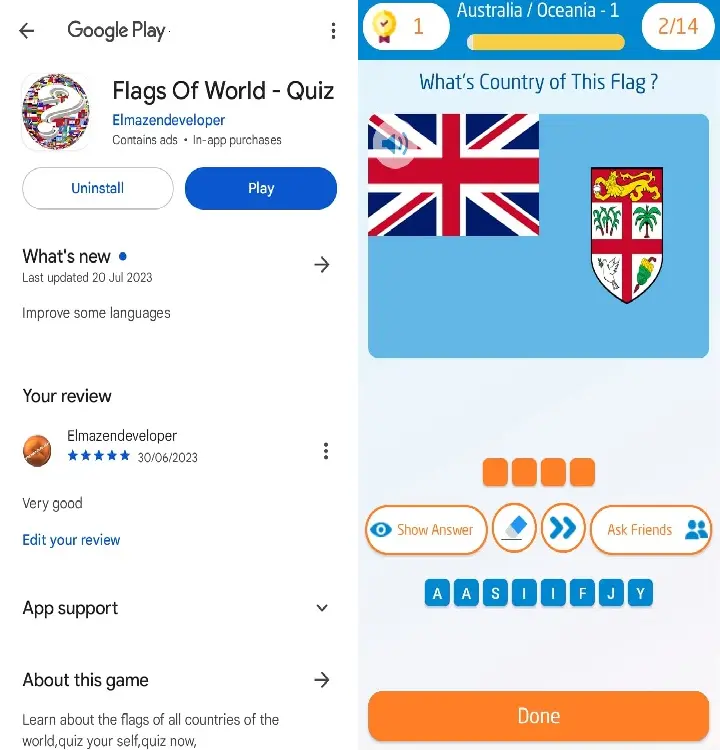
Download the application  Flags Of World - Quiz ,
Flags Of World - Quiz ,
And test your knowledge with Flags of World ,
1. Population of Fiji
As of November 2024, Fiji’s population is approximately 930,500 people.
The majority reside on the two largest islands, Viti Levu and Vanua Levu.
Fiji’s population is diverse, with a mix of indigenous Fijians (iTaukei), Indo-Fijians (descendants of Indian indentured laborers), and other ethnic groups.
This diversity contributes to Fiji’s vibrant cultural landscape.
2. Fiji’s Flag and Its Meaning
Fiji’s flag features a light blue field, symbolizing the Pacific Ocean that surrounds the islands.
In the top left corner is the Union Jack, reflecting Fiji’s historical ties to Britain.
The shield on the flag includes:
- A red cross and St. George’s cross, representing Christianity.
- A lion holding a cacao pod, symbolizing Fiji’s legacy and agriculture.
- Sugarcane, a coconut palm, bananas, and a dove with an olive branch are depicted, signifying Fiji’s natural resources and peace.
3. Currency of Fiji
The official currency of Fiji is the Fijian Dollar (FJD).
It is widely accepted across the islands and available in coins and banknotes featuring iconic Fijian imagery, such as native flora and fauna.
Flag of Fiji

Download the application  Flags Of World - Quiz ,
Flags Of World - Quiz ,
And test your knowledge with Flags of World ,
4. Fiji’s Borders
Fiji is an island nation and does not share land borders with any country.
It is surrounded by the Pacific Ocean and is located near countries such as Vanuatu, Tonga, and New Caledonia.
Its remote location adds to its charm as a tranquil getaway.
5. Culture of Fiji
Fiji’s culture is a beautiful blend of indigenous traditions and influences from India, Europe, and China.
Key aspects of Fijian culture include:
- Kava ceremonies: A communal tradition where a drink made from the kava root is shared.
- Traditional dances: The meke, combining storytelling, dance, and music.
- Fijian cuisine: Dishes like kokoda (marinated fish in coconut milk) and lovo (earth oven cooking) reflect local flavors.
- Community spirit: Known as bula spirit, Fijians are famously warm, friendly, and welcoming.
6. Best Places to Visit in Fiji
Fiji offers a wealth of stunning destinations for visitors.
Some of the top spots include:
- Mamanuca Islands: Known for luxury resorts and vibrant coral reefs.
- Yasawa Islands: Perfect for exploring pristine beaches and traditional Fijian villages.
- Viti Levu: Home to the capital, Suva, and attractions like the Sigatoka Sand Dunes and Navala Village.
- Taveuni Island: Called the "Garden Island" for its lush rainforests and waterfalls, such as Bouma Falls.
- Beqa Lagoon: A hotspot for scuba diving and shark encounters.
- Savusavu: Known for its geothermal hot springs and laid-back charm.
Fiji’s enchanting natural beauty, rich cultural heritage, and welcoming people make it a dream destination for travelers.
Whether you’re drawn by its beaches, traditions, or adventure, Fiji has something unforgettable to offer.
Flag of Fiji

Download the application  Flags Of World - Quiz ,
Flags Of World - Quiz ,
And test your knowledge with Flags of World ,
- Details
- Written by: Elmazen
- Category: Flags of Countries of the World
- Hits: 679
Flag of Australia
Flag of Australia, Currency, Population, Tourist Places, Culture, Borders
Discovering Australia: A Land of Wonders
Australia, the land of breathtaking landscapes, unique wildlife, and rich culture, is a destination that captivates the hearts of millions.
Here's a detailed look into what makes this country extraordinary.
Flag of Australia
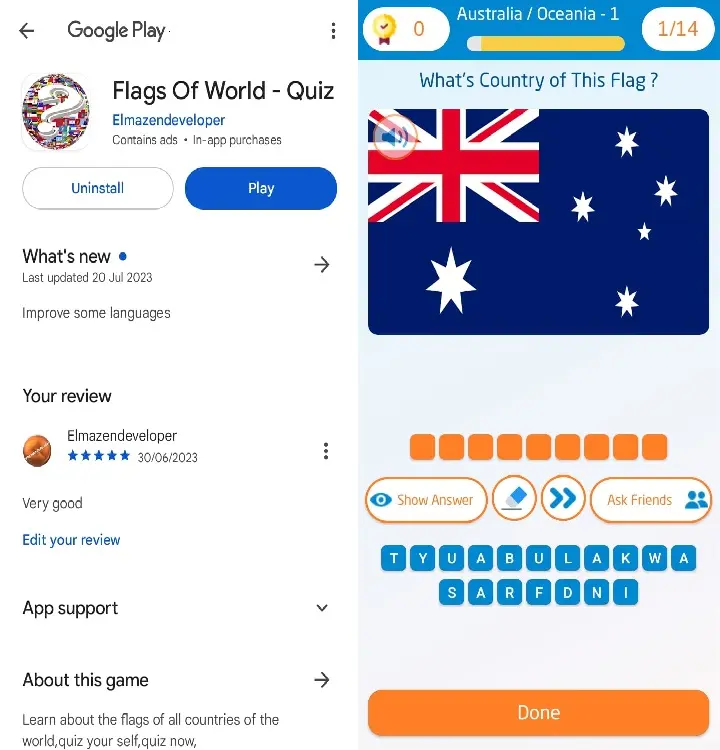
Download the application  Flags Of World - Quiz ,
Flags Of World - Quiz ,
And test your knowledge with Flags of World ,
1. Population of Australia
As of November 2024, Australia has an population of around 26.8 million people.
Most Australians live in urban areas, with major cities like Sydney, Melbourne, Brisbane, Perth, and Adelaide being home to the majority.
Despite its vast size, Australia is one of the most sparsely populated countries in the world, with much of its interior being uninhabited or sparsely populated.
2. Australia's Flag and Its Meaning
The Australian flag features a combination of elements that symbolize its history and identity:
- Union Jack: Represents Australia's historical ties to the United Kingdom.
- Commonwealth Star: A large seven-pointed star below the Union Jack, symbolizing the unity of Australia's six states and its territories.
- Southern Cross: A constellation visible in the southern hemisphere, representing Australia's geographical location.
The flag reflects Australia's history, unity, and connection to the southern hemisphere.
3. Australia's Currency
Australia's official currency is the Australian Dollar (AUD).
It's often symbolized as $ or A$ to differentiate it from other dollar-based currencies.
Known for its vibrant polymer banknotes featuring native wildlife and significant figures, the Australian dollar is a robust and widely traded currency in global markets.
Flag of Australia

Download the application  Flags Of World - Quiz ,
Flags Of World - Quiz ,
And test your knowledge with Flags of World ,
4. Australia's Borders
Australia is unique as it is both a country and a continent.
It is surrounded entirely by water, bordered by:
- The Indian Ocean to the west.
- The Pacific Ocean to the east.
- The Southern Ocean to the south.
- Neighboring countries include New Zealand to the southeast, and Indonesia, Papua New Guinea, and East Timor to the north.
Being an island nation, Australia has no land borders with other countries.
5. Culture of Australia
Australia's culture is a vibrant mix of indigenous traditions, British heritage, and multicultural influences:
- Indigenous Heritage: The Aboriginal and Torres Strait Islander peoples are the original custodians of the land, with over 60,000 years of rich cultural history.
Their art, music, and spiritual connection to the land remain a vital part of Australia's identity.
- Multiculturalism: Over the years, immigration has shaped Australia into a diverse society with influences from Asia, Europe, and the Americas.
This diversity is reflected in its food, festivals, and traditions.
- Sports: Australians are passionate about sports like cricket, rugby, Australian Rules Football (AFL), and swimming.
- Lifestyle: A love for outdoor activities, beach culture, and a laid-back attitude define the Australian way of life.
6. Best Places to Visit in Australia
Australia is home to stunning natural wonders, vibrant cities, and unique wildlife.
Here are some must-visit destinations:
- Great Barrier Reef: The world’s largest coral reef system, perfect for snorkeling and diving.
- Sydney Opera House and Harbour Bridge: Iconic landmarks located in Australia’s largest city.
- Uluru (Ayers Rock): A sacred sandstone monolith in the Northern Territory.
- Great Ocean Road: A scenic coastal drive in Victoria featuring the Twelve Apostles.
- Kangaroo Island: Famous for its wildlife and pristine beaches.
- Daintree Rainforest: One of the world's oldest rainforests, located in Queensland.
- Tasmania: Known for its untouched wilderness and unique wildlife.
- Bondi Beach: A world-famous beach in Sydney perfect for surfing and relaxation.
Australia is a land of contrast, where ancient traditions meet modern innovation, and natural wonders blend seamlessly with vibrant urban life.
Whether you're drawn by its cultural richness, its stunning landscapes, or its relaxed vibe, Australia has something for everyone.
Flag of Australia
